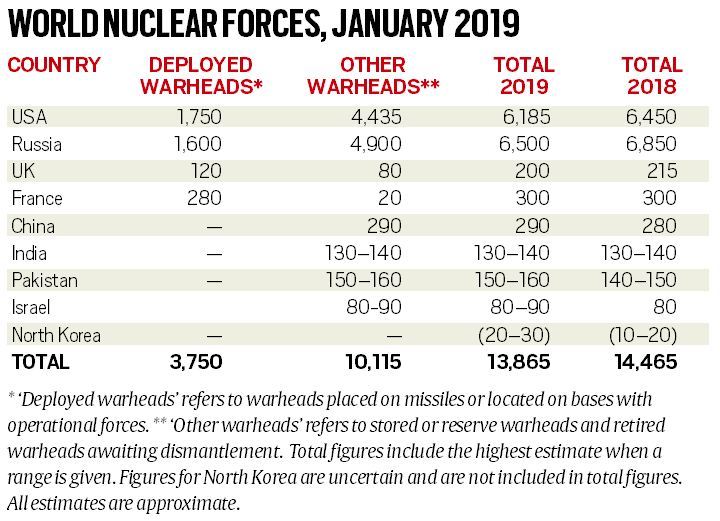Why in news?
The Stockholm International Peace Research Institute (SIPRI) has released, SIPRI Yearbook 2019 on the current state of armaments, disarmament and international security.
What are the key findings of the report?
- The report states that the all 9 nuclear weapon-possessing states are reducing nuclear warheads but are modernising their arsenals.
- These 9 nuclear-armed countries had atotal of some 13,865 nuclear weapons at the start of 2019
- This is a decreasefrom 14,465 at the start of 2018.
- It attributed the decrease mainly to Russia and the US(together still account for over 90 per cent of the total nuclear weapons)in pursuant of implementing the New START treaty of 2010.
- America -Focuses on its non-strategic nuclear arsenaland this could push other nations in the same direction.
- China, India and Pakistan -Increasing the size of their nuclear arsenals.
- India and Pakistan -Expanding their military fissile material production capabilities.
- North Korea -Continues to prioritize its military nuclear programme as a central element of its national security strategy.
- The report sites that theabsence of transparencyon the status of the nuclear arsenals and capabilities of the nuclear-armed states.
- The report separately counts
- Deployed warheads (warheads placed on missiles or located on bases with operational forces) and
- Other warheads (stored or reserve warheads and retired warheads awaiting dismantlement).

How the countriesare rated?
- India and Pakistan:
- For India, figure of 130-140 other warheads in 2019, the same as in 2018.
- For Pakistan, figure of 150-160 warheads.
- Both nations are estimated to have increased their arsenal by 10 to 20 warheads in 2018.
- US and Russia: Reduction in thestrategic nuclear forces of US and Russiais due to
- Implementation of the New START2010 (Treaty on Measures for the Further Reduction and Limitation of Strategic Offensive Arms)
- Unilateral reductions by both the countries.
- Programmes under way to replace and modernize their arsenal.
- Both are concentrating on the development of their non-strategic nuclear arsenal.
- North Korea: Figures for North Korea were not added to the total on account of uncertainty.
- China: It’s working to expand its nuclear forces.It’s also committed to a no-first-use policy, however has also taken steps to improve its retaliation response.
Quick Facts
Nuclear weapon-possessing countries - The United States of America, Russia, the United Kingdom, France, China, India, Pakistan, Israel and North Korea.
SIPRI (The Stockholm International Peace Research Institute):
- SIPRI is an independent international institute and a think tank established in 1966.
- Headquarter: Stockholm.
- Vision: A world in which sources of insecurity are identified and understood, conflicts are prevented or resolved, and peace is sustained.
- It researches into conflict, armaments, arms control and disarmament.
- SIPRI provides data, analysis and recommendations, based on open sources, to policymakers, researchers, media and the interested public.
New START (New Strategic Arms Reduction treaty):
- Signed by Russia and the United States
- Purpose: Reducing U.S. and Russian strategic nuclear arsenals by a bipartisan verification of the reduction.
- Signed: 2010
- Entered into force: 2011
- Replaced the 1991 START I treaty, which expired December 2009
- Superseded the 2002 Strategic Offensive Reductions Treaty (SORT), which terminated when New START entered into force.
- Both Russia and the United States announced that they met New START limitations by Feb. 5, 2018.
- New START will expire in 2021 unless both parties agree to extend it.
Nuclear weapon types
Non-strategic weapons or Tactical Nuclear Weapons (TNW)
- May be shorter-range delivery systems with lower yield warheads that might be used to attack troops or facilities on the battlefield.
- For use in battle, as part of an attack with and often in close proximity to friendly conventional forces possibly on contested friendly territory.
- They have included nuclear mines; artillery; short-, medium-, and long-range ballistic missiles; cruise missiles and gravity bombs.
Strategic nuclear weapons
- Longer-range delivery systems that is designed to be used on targets often in settled territory far from the battlefield as part of a strategic plan,
- Targets may include military bases, military command centres, arms industries, transportation, economic, and energy infrastructure, and heavily populated areas such as cities and towns, which often contain such targets.
Source: Indian Express, Business Insider.
